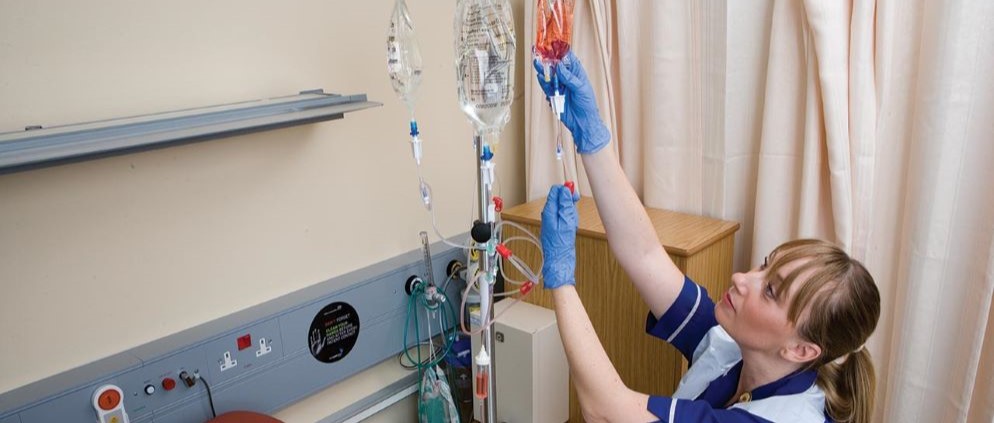Occupational cancer: How you can help reduce the risk
Healthcare workers (HCWs) who handle hazardous drugs (HDs) or hazardous medicinal products (HMPs) have a highly significant genotoxic risk, which may result in occupational cancer, when compared with control groups.1,2 Occupational cancer was responsible for an estimated 53% of all work-related deaths in the European Union (EU) in 2015.3
An important step was taken to help protect HCWs from exposure to HDs with the implementation of the EU Directive 2022/431 (EU-CMRD) and its transposition into the national laws of EU member states.4 This is an important milestone for HCWs across Europe.
Exposure to HD contamination
Out of all HCWs exposed to HD contamination in the EU, 40% are nurses, 11% are pathology laboratory technicians and 9% are pharmacists.5 In a study conducted in 12 French hospitals between 2008 and 2012, Ndaw et al. found that nurses and nurse’s aides on oncology wards were more exposed to HDs than pharmacists and pharmacy technicians.6
Exposure can occur through three main routes: oral ingestion, inhalation or dermal contact.7 Absorption through the skin has been suggested as the most likely route of exposure in healthcare facilities.8
HD exposure and occupational cancer risk
Now, it’s time to understand the link between HD contamination and the risk of developing occupational or work-related cancer. It has been shown that nurses exposed to HDs have an increased risk of developing breast or rectal cancer.9 A population-based cohort study in Taiwan demonstrated that male pharmacists have a higher risk of prostate cancer than males in the general population and female pharmacists have a higher risk of breast cancer than females overall.10
An HCW may be exposed to workplace contamination for years or even decades before being diagnosed with cancer.11
More on this topic: Safe handling of hazardous drugs: applying the CMRD in Ireland
HCW experience of occupational cancer
It can be difficult for HCWs when they become patients.12
As patients with cancer, they may experience:
- Denial in the early stages of illness13
- “Role ambiguity,” defined as “struggling to reverse the role from being an HCW to being a patient”14
- Guilt over workload-related concerns because of their sick leave13
- Anxiety because colleagues knew their diagnosis and prognosis13
- Stress from colleagues caring for them14
- Loss of control14
- Vulnerability14
- Difficulties returning to work after cancer treatment13
- Altered ability to work due to physical, psychological and social needs13
- Enhanced understanding of their own patients’ difficulties and challenges14
According to the World Health Organisation (WHO), 30–50% of all cases of cancer can be prevented.15 “Reducing the suffering caused by cancer is a priority for us, and to do so, prevention is key,” said Stella Kyriakides, EU Commissioner for Health and Food Safety.16
Now that you know about occupational cancer risk, find out how to help protect yourself and your colleagues. Beyond basic safety measures (e.g., personal protective equipment and isolators), there’s so much more that can be done. Prevention starts with knowing where the risks are.
Seven practice recommendations to help reduce your exposure to HD contamination
- Promote a culture of safety based on individual accountability and process improvement17
- Use safe-handling precautions when opening chemotherapy medication packaging before preparation18
- Introduce closed-system transfer devices (CSTDs) during preparation and administration to help decrease surface contamination from HDs19
- Carry out regular surface monitoring with wipe sampling20
- Ensure there is a specific standard operating procedure, staff training and kit for managing HD spills21
- Combine cleaning techniques to deactivate, decontaminate, clean and disinfect potentially contaminated work surfaces21
- Make sure your occupational safety and health officer conducts risk assessments to determine adverse health effects at assessed exposure levels22
“While the majority of occupational hazards have been successfully addressed by legislation at the European and national level, much remains to be done when it comes to the exposure of HCWs to chemical risks during activities such as the preparation and administration of cytotoxic drugs used to treat patients with cancer,” according to a report by the European Parliament.11
References
- Roussel C, Witt KL, Shaw PB, Connor TH. Meta-analysis of chromosomal aberrations as a biomarker of exposure in healthcare workers occupationally exposed to antineoplastic drugs. Mutat Res. 2019;781:207-217. doi:10.1016/j.mrrev.2017.08.002
- Hagmar L, Brøgger A, Hansteen IL, et al. Cancer risk in humans predicted by increased levels of chromosomal aberrations in lymphocytes: Nordic study group on the health risk of chromosome damage. Cancer Res. 1994;54(11):2919-2922.
- European Agency for Safety and Health at Work (EU-OSHA). Work-related cancer. Published July 26, 2023. Accessed February 13, 2024. https://osha.europa.eu/en/themes/work-related-diseases/work-related-cancer
- European Parliament. DIRECTIVE (EU) 2022/431 OF THE EUROPEAN PARLIAMENT AND OF THE COUNCIL of 9 March 2022 amending Directive 2004/37/EC on the protection of workers from the risks related to exposure to carcinogens or mutagens at work. Published March 16, 2022. Accessed May 27, 2024. https://eur-lex.europa.eu/legal-content/EN/TXT/PDF/?uri=CELEX:32022L0431#:~:text=This%20Directive%20has%20as%20its,the%20prevention%20of%20such%20risks.
- European Commission. Study Supporting the Assessment of Different Options Concerning the Protection of Workers from Exposure to Hazardous Medicinal Products, Including Cytotoxic Medicinal Products.; 2021. Accessed February 13, 2024. https://op.europa.eu/en/publication-detail/-/publication/f43015ec-a24f-11eb-b85c-01aa75ed71a1
- Ndaw S, Denis F, Marsan P, Rémy A. Exposition professionnelle des personnels de santé hospitaliers aux médicaments cytotoxiques. Biométrologie et mesure de la contamination de surface. Réf Santé Trav. 2018;154:81-92.
- Crul M, Hilhorst S, Breukels O, Bouman-d’Onofrio JRC, Stubbs P, van Rooij JG. Occupational exposure of pharmacy technicians and cleaning staff to cytotoxic drugs in Dutch hospitals. J Occup Environ Hyg. 2020;17(7-8):343-352. doi:10.1080/15459624.2020.1776299
- Connor TH, Zock MD, Snow AH. Surface wipe sampling for antineoplastic (chemotherapy) and other hazardous drug residue in healthcare settings: Methodology and recommendations. J Occup Env Hyg. 2016;13(9):658-667. doi:10.1080/15459624.2016.1165912
- Ratner PA, Spinelli JJ, Beking K, et al. Cancer incidence and adverse pregnancy outcome in registered nurses potentially exposed to antineoplastic drugs. BMC Nurs. 2010;9:15. doi:10.1186/1472-6955-9-15
- Lin YW, Lin CH, Pai LW, Mou CH, Wang JY, Lin MH. Population-Based Study on Cancer Incidence in Pharmacist: A Cohort Study in Taiwan. Int J Environ Res Public Health. 2021;18(23). doi:10.3390/ijerph182312625
- Erce A. Preventing occupational exposure to cytotoxic and other hazardous drugs European Policy Recommendations. European Parliament. Published 2016. Accessed June 18, 2024. https://www.europeanbiosafetynetwork.eu/wp-content/uploads/2016/05/Exposure-to-Cytotoxic-Drugs_Recommendation_DINA4_10-03-16.pdf
- Prenkert M, Carlsson E, Svantesson M, Anderzén-Carlsson A. Healthcare-professional patients’ conceptions of being ill and hospitalised – a phenomenographic study. J Clin Nurs. 2016;26(11-12):1725-1736. doi:10.1111/jocn.13604
- Mitchell T. Both sides of the couch: a qualitative exploration of the experiences of female healthcare professionals returning to work after treatment for cancer. Eur J Cancer Care (Engl). 2015;24(6):840-853. doi:10.1111/ecc.12308
- Hunt L, Buckley T. The experiences and challenges of nurses who become patients in a hospital setting: A scoping review of the literature. J Adv Nurs. 2024;80(1):110-123. doi:10.1111/jan.15834
- World Health Organisation (WHO). Preventing cancer. Published 2024. Accessed June 19, 2024. https://www.who.int/activities/preventing-cancer
- European Commission. Beating cancer: Better protection of workers against cancer-causing chemicals. Published 2020. Accessed June 19, 2024. https://ec.europa.eu/commission/presscorner/api/files/document/print/en/ip_20_1691/IP_20_1691_EN.pdf
- Nickel B, Gorski L, Kleidon T, et al. Infusion Therapy Standards of Practice, 9th Edition. J Infus Nurs. 2024;47(1S Suppl 1):S1-S285. doi:10.1097/NAN.0000000000000532
- Connor TH, Sessink PJM, Harrison BR, et al. Surface contamination of chemotherapy drug vials and evaluation of new vial-cleaning techniques: results of three studies. Am J Health-Syst Pharm AJHP Off J Am Soc Health-Syst Pharm. 2005;62(5):475-484. doi:10.1093/ajhp/62.5.475
- Sessink PJM, Trahan J, Coyne JW. Reduction in Surface Contamination With Cyclophosphamide in 30 US Hospital Pharmacies Following Implementation of a Closed-System Drug Transfer Device. Hosp Pharm. 2013;48(3):204-212. doi:10.1310/hpj4803-204
- Kiffmeyer TK, Tuerk J, Hahn M, et al. Application and assessment of a regular environmental monitoring of the antineoplastic drug contamination level in pharmacies – the MEWIP project. Ann Occup Hyg. 2012;57(4):444-455. doi:10.1093/annhyg/mes081
- ISOPP Standards for the Safe Handling of Cytotoxics. J Oncol Pharm Pract. 2022;28(3_suppl):S1-S126. doi:10.1177/10781552211070933
- Forsa, European Biosafety Network (EBN), Hospital Pharmacists Association of Ireland (HPAI), National Association of Hospital Pharmacy Technicians (NAHPT) Ireland. Joint Summit: Preventing occupational exposure to Hazardous Medicinal Products (HMPs). Published January 30, 2024. Accessed June 19, 2024. https://www.europeanbiosafetynetwork.eu/joint-summit-preventing-occupational-exposure-to-hazardous-medicinal-products-hmps/
This list of references to third-party peer-reviewed material and the sites they are hosted on are provided for your reference and convenience only, and do not imply any review or endorsement of the material or any association with their operators. The Third-Party References (and the Web sites to which they link) may contain information that is inaccurate, incomplete, or outdated. Your access and use of the Third Party Sites (and any Web sites to which they link) is solely at your own risk.
BD-131333




